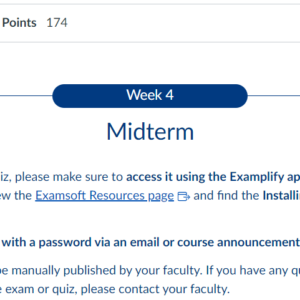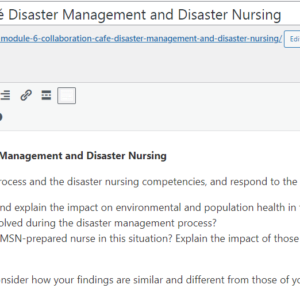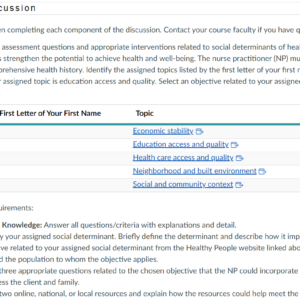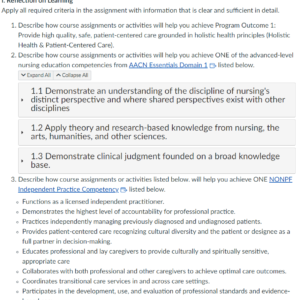i-Human Virtual Patient Encounter Practice Case and Self-Assessment
General Instructions
Throughout this course, you will have opportunities to engage with simulated patients using the i-Human virtual learning environment. For this assignment, you will complete the i-Human practice case and score your performance using the i-Human grading rubric. Completing the practice case and applying the grading rubric will help you learn to navigate the virtual simulation software, engage effectively and proficiently with a virtual patient, and understand grading expectations for i-Human assignments.
Open and review the grading rubric for the i-Human Virtual Patient Encounter. You may choose to download or print the rubric to use as a reference during your virtual encounter.
Access the i-Human practice case by clicking the link provided below. Clicking the blue bar will launch the activity in a new browser window. You do not need to complete the case in one sitting; if you leave the case and return later, the program will begin where you left off.
All graded documentation, including the Management Plan, must be completed within the i-Human platform. Follow the i-Human Documentation GuideLinks to an external site. and the grading rubric as you prepare your client’s EHR and management plan.
Include the following sections (detailed criteria listed below and in the grading rubric):
Complete the following components in the i-Human Virtual Patient Encounter for the practice case for Marvin F. Webster.
- Focused Health History
- Complete a focused health history. Scores are automatically calculated within the i-Human platform when the health history is submitted.
- Focused Physical Exam
- Complete a focused physical exam. Scores are automatically calculated within the i-Human platform when the health history is submitted.
- EHR Documentation (Subjective Data): Document the history of present illness (HPI) and focused review of systems (ROS). Documentation must be:
- accurate
- detailed
- written using professional terminology
- pertinent to the chief complaint
- includes subjective findings only
- EHR Documentation (Objective Data): Document physical exam findings. Documentation must be:
- accurate
- detailed
- written using professional terminology
- pertinent to the chief complaint
- include objective findings only
- Key Findings: Organize key findings from the history and physical exam.
- Problem Statement: Document a brief, accurate problem statement using professional language. Include the following components:
- name or initials, age
- chief complaint
- positive and negative subjective findings
- positive and negative objective findings
- Management Plan: Use the expert diagnosis provided to create a pertinent comprehensive evidence-based management plan. If a specific component of the management plan is not warranted (i.e., no referrals are appropriate for the virtual patient) document that no intervention is warranted. Include the following components:
- diagnostic tests
- medications: Type a specific prescription for each medication, including over-the-counter medications
- suggested consults/referrals
- client education
- follow-up, including time interval and specific symptomatology to prompt a sooner return
- Provide rationales for each intervention and cite at least one relevant scholarly source as defined by program expectations
- Click ”Submit” once the case is complete. Use this guide to download the Performance Overview ReportLinks to an external site..
- Reflection: Download this worksheet.. Type your reflection responses on the worksheet and upload the worksheet including the title page to the designated drop box for the assignment in Canvas.
- Assess your ability to gather information on your client within the i-Human Virtual Patient Encounter.
- Use the i-Human score sheet to review your results for the focused health history and focused physical exam. How did you perform?
- What did you find easy or difficult about navigating through focused health history and focused physical exam sections of the case?
- Describe one strategy to improve your performance in the next Virtual Patient Encounter.
- Assess your performance in documenting your findings on the electronic health record (EHR).
- What did you find easy or difficult about navigating through the documentation of history and physical within the system?
- Did you document all required components in the case?
- Describe one strategy to improve your performance in the next Virtual Patient Encounter.
- Assess your performance in determining key findings and reviewing the most significant active problem.
- What did you find easy or difficult about navigating through the key findings and organization section of the case?
- How did your key findings compare with the expert’s findings?
- Describe one strategy to improve your performance in the next Virtual Patient Encounter.
- Assess your performance in creating and documenting a problem statement within the i-Human case.
- What did you find easy or difficult about creating the problem statement?
- How did your problem statement compare with the expert’s response provided?
- Describe one strategy to improve your performance in the next Virtual Patient Encounter.
- Assess your performance in creating and documenting a management plan within the i-Human case.
- What did you find easy or difficult about creating the management plan?
- How did your management plan compare with the expert’s response provided?
- Describe one strategy to improve your performance in the next Virtual Patient Encounter.
- Assess your ability to gather information on your client within the i-Human Virtual Patient Encounter.
SOLUTION
-
- Use the iHuman score sheet to review your results for the focused health history and focused physical exam. How did you perform?
It was relatively easy for me to obtain basic facts concerning Marvin Webster’s health condition and signs. As the case moved forward my attention to questions of relevance increased; however, the capacity at times to discern which questions would be most productive in eliciting relevant data was at times unclear. Scoring the iHuman client interview checklist was useful because again it gave me an indication of those questions that I may have overlooked or where perhaps I needed to ask more questions concerning the client’s symptoms………………………………purchase the full solution at $10






Reviews
There are no reviews yet.